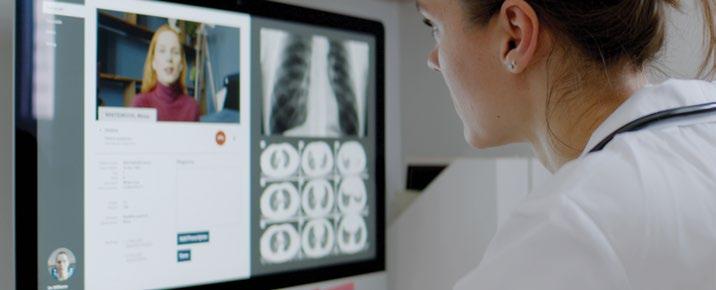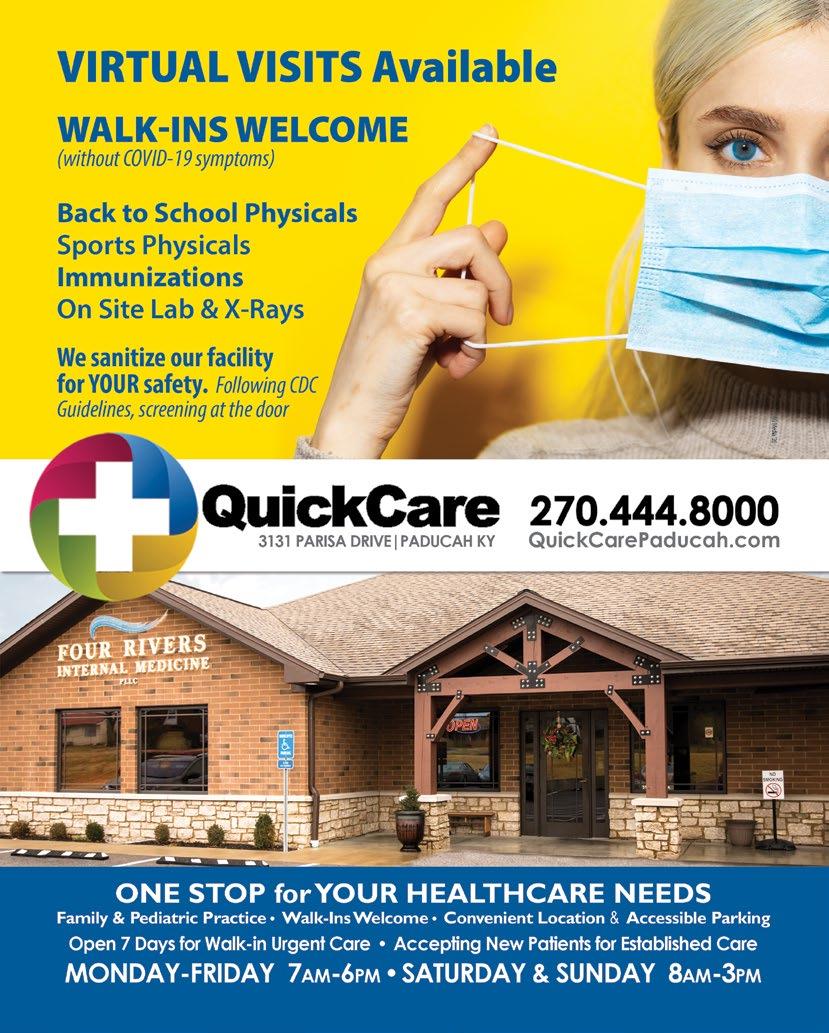
6 minute read
iDoctor: See Your Doctor Virtually Understanding & Using Telehealth
So many things have changed because of the pandemic and one of the most innovative is the use of telehealth visits to the doctor. Many health care providers and specialists are strongly urging patients to use telehealth appointments for routine care. While some clinics are seeing a limited number of patients, most are reserving in-person visits only for serious issues or treatments that must be done in person.
“Anyone can have a doctor’s visit using telehealth,” said Cainan Jones, APRN at Four Rivers Internal Medicine/QuickCare in Paducah. “Whether you are a new patient, established patient, or walk-in. However, please note that at QuickCare, if you are experiencing ANY COVID-19 symptoms, you will automatically be seen via telehealth rather than in person.”
Advertisement
"You get the same quality of care with telehealth that you would get in person,” added Jones. “The provider is focusing on YOU, the patient. You have their full attention. Just because you aren't physically in person with your provider doesn't mean you are getting less care."
What Is Telehealth? Telehealth, or telemedicine, means seeing your provider over a video/ audio service, like FaceTime, Skype, or a specific app intended for this purpose. It can also include phone calls.
The biggest benefit of telehealth is that you get immediate access to your health care provider without any potential exposure to the virus. Until we get more widespread testing, we don’t know who might be sitting next to you in the waiting room - or which provider may have been exposed to the virus.
New Rules on Telehealth Telemedicine is far from new, but it is becoming more widely used as public health experts continue to look for ways to flatten the curve and protect high-risk patients from potential COVID-19 exposure.
Under the President’s emergency declaration, the Centers for Medicare & Medicaid Services (CMS) loosened HIPAA health privacy laws for telehealth. This allows health care professionals without HIPAA-approved platforms to use the following apps to diagnose and treat patients: Apple FaceTime, Facebook Messenger video chat, Google Hangouts video, and Skype. Doctors may also utilize specific telehealth platforms through their electronic medical record software.
iDOCTOR See Your Doctor Virtually
Understanding and Using Telehealth
CMS created new billing codes specifically for telehealth appointments, which means doctors can be reimbursed for these visits similarly to how they would get paid for regular in-person appointments. In other words, these new changes have removed a lot of the red tape that used to prevent doctors from being able to easily adopt telehealth and make it part of their practice.
Ways to Utilize Telehealth Some doctors, such as those in primary care, may be using telehealth to screen patients for coronavirus symptoms and decide whether people need to get tested.
And in addition to using telehealth for regular check-ups for managing chronic health conditions, telehealth can also be used for one-off minor health issues to avoid needing to go to the doctor in person - say, for a rash or an upset stomach.


“Numerous conditions can be taken care of with a telehealth visit,” said Mariah Hamby, APRN at QuickCare. “If you need something like sutures, which obviously cannot be done unless you are in person. But everything from bug bites to a question about medication, or even a virus can be managed over telehealth.”
Telehealth services can also provide virtual mental health support and several providers in western Kentucky are offering this type of visit. Whether you need a prescription refill or you’re managing a chronic health condition such as arthritis, telehealth is a great option.
How Telehealth Works Telehealth visits allow your doctor to evaluate your symptoms and determine what to do next - without you having to take multiple trips outside your home. Most calls last under 15 minutes. It’s simple and easy.
For a routine, scheduled visit, a patient might call and login using Zoom (cloud-based video communication app) on their computer or phone. You are able to see and hear the physician - and the physician can see and hear you.
“Each medical office has their own preference for how they conduct telehealth visits,” said Jessie Meiser, APRN at QuickCare. “Some strictly use an app, others do telehealth based on what kind of technology the patient has on their phone. If you have an iPhone, it is possible to do Facetime for the visit rather than using an app. If you have an Android phone/tablet, an app will most likely be needed. Providers can text a link with instructions to you that you with step by step instructions on what to do.” “Telehealth is very similar to a face-to-face visit,” explained Cody Sexton, APRN at QuickCare. “First, a nurse will call you and ask all of the same questions they would ask you in the office - medication list, what your symptoms are, why you need to be seen, etc. If you can take your blood pressure, weight, and temperature at home, they will ask you to do that as well. “If tests are required, you will be scheduled for a time to do those,” said Sexton. “If you are having COVID-19 symptoms and need to be tested, we will schedule a time for you to come to our drive-thru testing.” Naysayers of telehealth often cite the lack of a physical exam as being problematic but a virtual visit is not the end of the line. Your physician is going to use their medical knowledge. They know what’s routine and expected versus what’s out-of-the-ordinary and when a patient may have to come into the office. The virtual visit is the trigger. It helps us understand whether a patient may need to get x-rayed or have labs done. Then they can reconnect, and based on the results, determine if you need to come in or if they can prescribe medication over the phone. You don’t necessarily have to touch to treat.
What to Ask Your Doctors If you have an upcoming appointment scheduled with your doctor it’s a good idea to call and ask whether the appointment can be conducted as a telehealth visit. Each practice will have its own process for using telehealth. It’s a good idea to make sure you understand what to expect and how you will log on to speak with the doctor.
You should ask what to expect in terms of insurance coverage and payment. You will likely still have your usual coinsurance or copay; though it might be less than usual if your appointment is more limited in scope.
You can also contact your insurance carrier to inquire if they offer any telehealth services as well as what is (and what isn’t) covered outside of these services. To help keep at-risk seniors safe during COVID-19, Medicare (administered by CMS) will allow health providers to waive or reduce cost-sharing for telehealth visits.
“Telehealth visits are treated the same as an in office visit,” Jones said. “Each insurance is different, but most insurance companies cover
Telehealth visits. It is still considered a doctors visit." Telehealth is a smart way to reduce your exposure to COVID-19 and to stay safe, but take heart. If you do have to schedule an in-person visit with your doctor, they are likely taking extra precautions to keep their patients safe.
"During these uncertain times, many patients feel unsafe going inside many places, doctors’ offices included,” said Hamby. “All healthcare facilities have many precautions to keep you safe. Screening patients at the door for a fever, asking patients to wait in their car rather than the waiting room, and no one with COVID-19 symptoms will be allowed inside. Rest assured knowing your provider is taking every precaution to keep patients and staff alike out of harm's way." *









